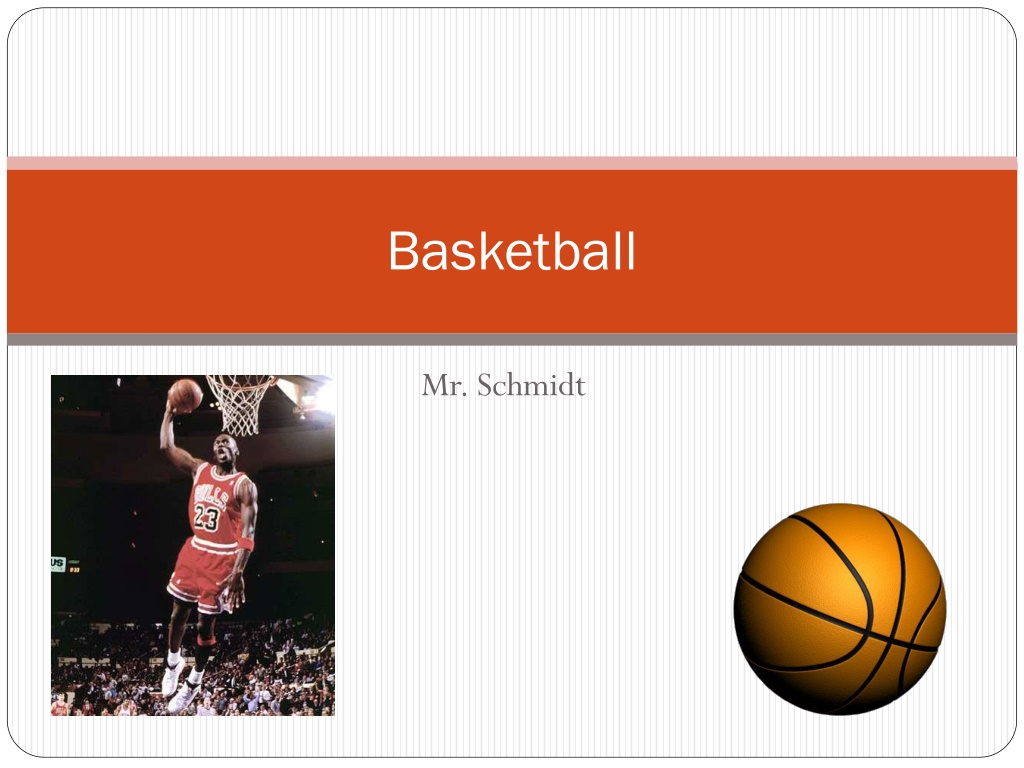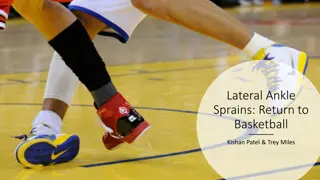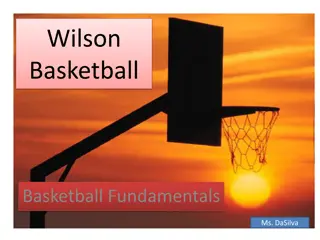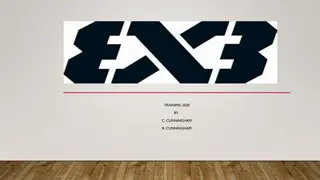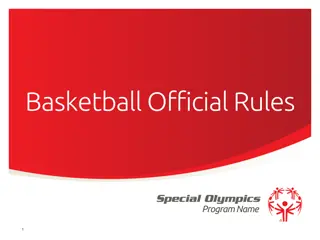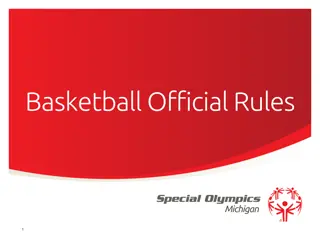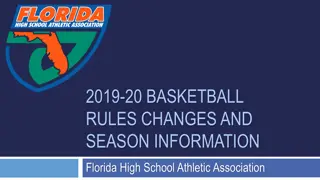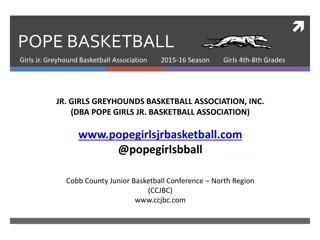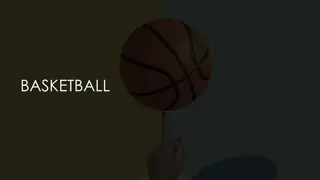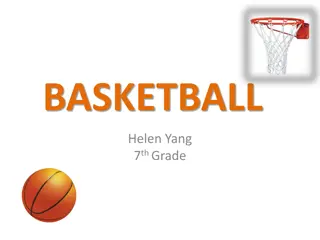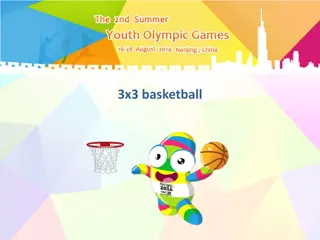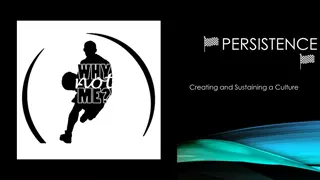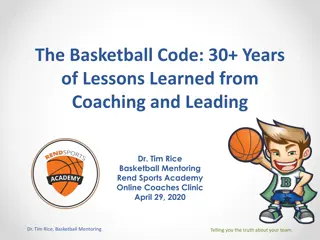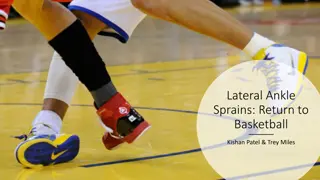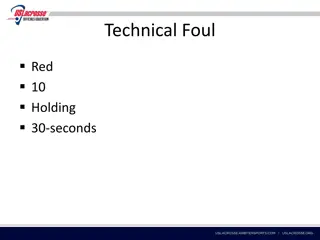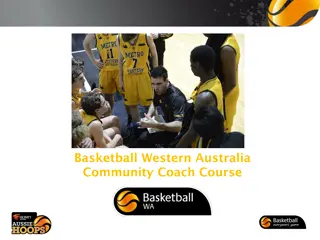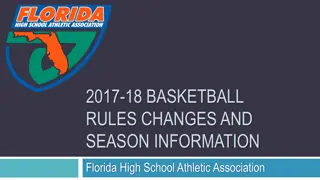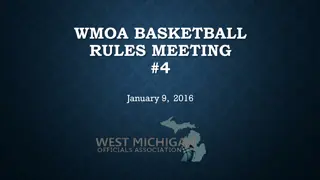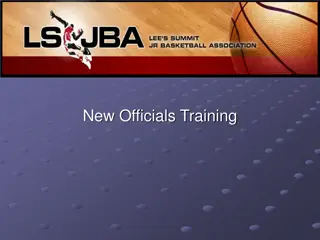Basketball Basics and Rules Explained
Basketball is a popular sport played by two teams, each with five players on the court. The objective is to score by shooting the basketball through the hoop. The game involves dribbling, passing, and preventing opponents from scoring. Violations like traveling, double dribble, and goaltending result in turnovers. Understanding key rules, court dimensions, and scoring methods is essential in enjoying and playing basketball.
Download Presentation

Please find below an Image/Link to download the presentation.
The content on the website is provided AS IS for your information and personal use only. It may not be sold, licensed, or shared on other websites without obtaining consent from the author. Download presentation by click this link. If you encounter any issues during the download, it is possible that the publisher has removed the file from their server.
E N D
Presentation Transcript
Basketball Mr. Schmidt
Basic Rules of Basketball Two teams each have five players on the court at one time Each team tries to score by shooting the basketball through the hoop The basketball is 29 inches around. This size is modified for younger players and girls competition. The hoop is an 18 inch cylinder attached to the backboard and positioned 10 feet off the ground. The height of the hoop is modified for younger players.
Basic Rules of Basketball Each team tries to prevent their opponent from scoring by stealing the ball or blocking a shot. The ball is moved down the court by either passing it to a teammate or dribbling it. The game continues until a basket is scored or the ball goes out of bounds. In either case, the opposite team would then gain possession of the ball. Scoring 3 pts 3 point shot 2 pts. For a field goal (inside the 3 point arch) 1 pt. for a free throw
Basketball Rules - Violations Walking/Traveling. Taking more than a step and a half without dribbling the ball is traveling. Moving your pivot foot once you ve stopped dribbling is traveling. Carrying/Palming.When a player dribbles the ball with his hand too far to the side of or, sometimes, even under the ball. Double Dribble. Dribbling the ball with both hands on the ball at the same time or picking up the dribble and then dribbling again is a double dribble. Held Ball. Occasionally, two or more opposing players will gain possession of the ball at the same time. In order to avoid a prolonged and/or violent tussle, the referee stops the action and awards the ball to one team or the other on a rotating basis.
Basic Rules-Violations Goaltending. If a defensive player interferes with a shot while it s on the way down toward the basket, while it s on the way up toward the basket after having touched the backboard, or while it s in the cylinder above the rim, it s goaltending and the shot counts. If committed by an offensive player, it s a violation and the ball is awarded to the opposing team for a throw-in. Backcourt violation. Once the offense has brought the ball across the midcourt line, they cannot go back across the line during possession . If they do, the ball is awarded to the other team to pass inbounds. Time Restrictions. A player passing the ball inbounds has five seconds to pass the ball. If he does not, then the ball is awarded to the other team. Other time restrictions include the rule that a player cannot have the ball for more than five seconds when being closely guarded and, in some states and levels, shot-clock restrictions requiring a team to attempt a shot within a given time frame.
Basketball Rules-Violations Some of the more common time violations are: You are only allowed 3 seconds in the lane 5 seconds in possession of the basketball You are only allowed 5 seconds to inbound the ball You are only allowed 10 seconds in the backcourt with the basketball. Play stops on all fouls. A foul is committed when a player initiates illegal contact with an opposing player. Fouls are committed by both offensive and defensive players, but more commonly by a defender.
Basketball Rules-Fouls After a foul is committed and depending on which type of foul it is, one of two things will happen: A. The opposing team gains possession of the ball, or B. the fouled player shoots free throws. Some of the common fouls are: Blocking, Charging, Holding, Illegal screen, Over-the-back, Reaching in, Shooting Fouls, and Tripping. Some other fouls that are sometimes committed are: Flagrant Fouls, Intentional Fouls, and Technical Fouls.
Player Positions Center- Centers are generally your tallest players. They generally are positioned near the basket. Offensive The center s goal is to get open for a pass and to shoot. They are also responsible for blocking defenders, known as picking or screening, to open other players up for driving to the basket for a goal. Centers are expected to get some offensive rebounds and put-backs. Defensive On defense, the center s main responsibility is to keep opponents from shooting by blocking shots and passes in the key area. They also are expected to get a lot of rebounds because they re taller.
Player Positions Forward Your next tallest players will most likely be your forwards. While a forward may be called upon to play under the hoop, they may also be required to operate in the wings and corner areas. Offensive Forwards are responsible to get free for a pass, take outside shots, drive for goals, and rebound. Defensive Responsibilities include preventing drives to the goal and rebounding.
Player Positions Guard These are potentially your shortest players and they should be really good at dribbling fast, seeing the court, and passing. It is their job to bring the ball down the court and set up offensive plays. Offensive Dribbling, passing, and setting up offensive plays are a guard s main responsibilities. They also need to be able to drive to the basket and to shoot from the perimeter. Defensive On defense, a guard is responsible for stealing passes, contesting shots, preventing drives to the hoop, and for boxing out.
Basketball Lingo Air Ball Describes an outside shot that completely misses everything: The backboard, rim and net Backboard (or glass) The wooden or glass board on which the basket hangs. It is used for bank shots. Backcourt and Frontcourt The names for the half-court areas in which the two teams play defense and offense respectively. One team front court is the opposing team s backcourt. Fast Break When the team on offense quickly moves the ball up the court before the opposing team can set up in their defensive position. Field Goal (or basket) A shot through the hoop (other than a free throw). A basket scores either two or three points. Fouled out If a player commits a certain number of fouls in a game (usually five or six fouls per player), he or she is removed from play. Give-and-go An offensive maneuver in which a player passes to a teammate, then moves quickly past his or her defender to receive a return pass and shoot a lay-up.
